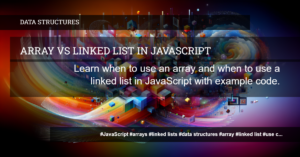Graphs are a fundamental data structure in computer science, used to represent relationships between objects. They are composed of vertices (or nodes) and edges, where the edges connect pairs of vertices. In this comprehensive guide, we will explore the concept of graphs in Java and delve into various graph representations and traversal algorithms.
Graph Representations
When it comes to representing a graph in Java, two commonly used approaches are the Adjacency Matrix and the Adjacency List.
- Adjacency Matrix: In this representation, a matrix of size V x V is used, where V is the total number of vertices in the graph. The matrix is initialized with all zeroes, and if there is an edge between two vertices i and j, the corresponding cell is set to 1. Otherwise, it remains 0. The adjacency matrix is suitable for dense graphs but requires a higher space complexity of O(V^2).
- Adjacency List: In this representation, a dynamic array of linked lists, or an array of ArrayLists, is used. Each index of the array represents a vertex, and the linked list or ArrayList at that index stores all the vertices that are adjacent to it. The adjacency list is suitable for sparse graphs and has a space complexity of O(V + E), where V is the number of vertices and E is the number of edges.
Graph Traversal Algorithms
Graph traversal algorithms are used to visit and explore all the vertices in a graph. Two popular algorithms for graph traversal are Depth First Search (DFS) and Breadth First Search (BFS).
- Depth First Search (DFS): This algorithm starts at a given vertex and explores as far as possible along each branch before backtracking. It uses a stack to keep track of the visited vertices and the order in which they are visited. DFS is typically implemented using recursion or an explicit stack data structure.
Breadth First Search (BFS): This algorithm explores all the vertices at each level of the graph before moving on to the next level. It uses a queue to maintain the order in which the vertices are visited. BFS is typically implemented using a queue data structure.
Both DFS and BFS have their own advantages and use cases. DFS is useful for finding connected components, detecting cycles, and traversing unweighted graphs. BFS, on the other hand, is suitable for finding the shortest path in unweighted graphs and solving problems like the “Minimum Moves to Reach Target” puzzle.
Implementation Example
Let’s look at an example of implementing a graph in Java using an adjacency list and performing DFS traversal on it:
import java.util.ArrayList;
import java.util.LinkedList;
import java.util.List;
class Graph {
private int numVertices;
private List<List<Integer>> adjacencyList;
public Graph(int numVertices) {
this.numVertices = numVertices;
adjacencyList = new ArrayList<>();
for (int i = 0; i < numVertices; i++) {
adjacencyList.add(new LinkedList<>());
}
}
public void addEdge(int source, int destination) {
adjacencyList.get(source).add(destination);
adjacencyList.get(destination).add(source);
}
public void dfsTraversal(int startVertex) {
boolean[] visited = new boolean[numVertices];
dfsUtil(startVertex, visited);
}
private void dfsUtil(int currentVertex, boolean[] visited) {
visited[currentVertex] = true;
System.out.print(currentVertex + " ");
for (int neighbor : adjacencyList.get(currentVertex)) {
if (!visited[neighbor]) {
dfsUtil(neighbor, visited);
}
}
}
}
public class Main {
public static void main(String[] args) {
int numVertices = 6;
Graph graph = new Graph(numVertices);
graph.addEdge(0, 1);
graph.addEdge(0, 2);
graph.addEdge(1, 3);
graph.addEdge(2, 4);
graph.addEdge(3, 4);
graph.addEdge(3, 5);
System.out.println("DFS Traversal:");
graph.dfsTraversal(0);
}
}
In this example, we create a graph with six vertices and add edges to it. We then perform a DFS traversal starting from vertex 0 and print the traversal path. The output will be: 0 1 3 4 2 5.
Graphs are a powerful data structure with various applications. Understanding how to represent graphs in Java and applying traversal algorithms such as DFS and BFS can be beneficial for solving graph-related problems efficiently.
In conclusion, this comprehensive guide provided an overview of graphs in Java, explored different graph representations, and discussed popular graph traversal algorithms. It also included an example implementation of a graph using an adjacency list and performing DFS traversal. By mastering these concepts, you will be well-equipped to tackle graph-related challenges in your Java programming journey.
References:




